Let’s take a moment to consider some of the most iconic animals of the Antarctic. The name that comes to your mind will be Penguins! These animals perform an Attention-grabbing action known as “porpoising.”
At “porpoising,” they leap out of the water and plunge back in like Dolphins. It’s a sight that stimulates lookers’ interest and imagination. Penguins exhibit an astounding range of activities by developing monogamous partnerships, giving their young the utmost attention, and working together during nesting and hunting.
But Penguins are more complex than just their typical behaviors. You will explore here how they communicate with each other, how they create and maintain social links, and some of the distinctive physical and behavioral adaptations that have made penguins thrive in extreme environments on Earth.
So, let’s dive in and discover the amazing world of Penguins together.
A Short Overview of Different Behavioral Traits
It could be excellent to provide a brief outline of Penguin’s behavioral facts before evaluating them in order to have a rapid knowledge of their way of life.
| Behavioral Traits | Key Facts- Description |
|---|---|
| Growing Habits | 1. Unique growth patterns 2. Physical Development Stages 3. Comparison among species. |
| Feeding Habits | 1. Penguins are carnivores 2. Adult Feeding 3. Chicks Feeding |
| Breeding Habits & Migration Patterns | 1. Breeding and mating process, 2. Courtship 3. breeding period, 4. Reason for migration |
| Ecological Adaptations | 1. Important facts about adaptations to the environment 2. Survival |
| Aggression & Territorial Habits | 1. Predators 2. Aggression 3. Foraging Food |
| Social Dynamics | 1. Interact socially, 2. Coordinate movements 3. Vocalization Skills |
Reasons for The Diverse Behavioral Traits of Penguins
Like other animals, penguins have evolved certain habits that allow them to survive and thrive in their natural habitats. We’ll go over a few of the factors that contribute to Penguin behaving as they do in this section:
- Finding Food
- Surviving
- Breeding
- Interacting with Other Species and Animals
Overall, Penguins’ unique behaviors are essential to their survival and success in their habitats. We can better appreciate and protect these incredible animals by studying and understanding these behaviors.
Interested to know further about Penguin overview? Check this article in my blog.
Significance of Understanding the Behavior of Penguin
It aids in the management and conservation of the species by giving researchers information about their migratory, feeding, and reproductive routines.
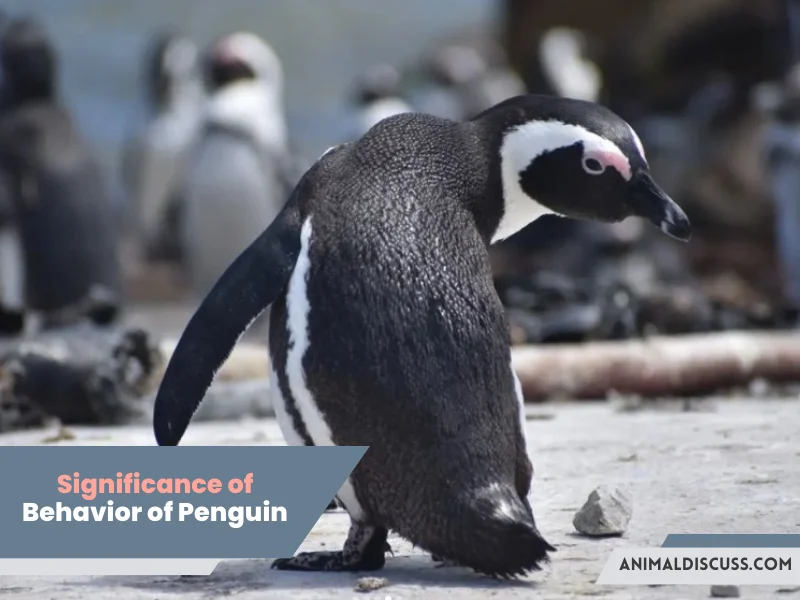
Understanding penguin behavior advances our comprehension of the larger marine ecology and its interdependence, emphasizing the necessity of protecting these lovable and critically essential animals. By comprehending their ecological roles, social structures, and adaptations, we can better understand penguins’ varied behavior to develop conservation strategies.
Growing Habits of Penguin
Penguins are renowned for their distinctive growth patterns, which are essential to their survival and environment adaptation. Conservationists can develop successful safeguards for Penguins by having a thorough understanding of their growth patterns.
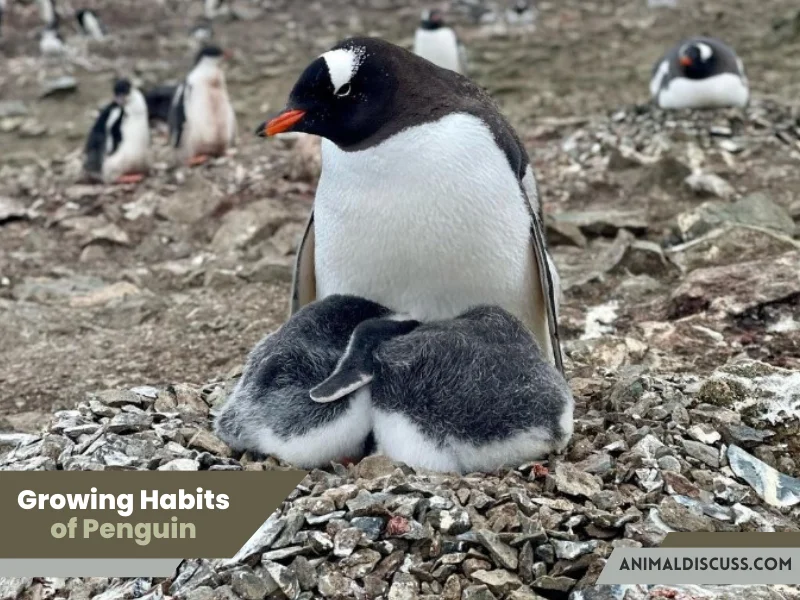
Physical Development Stages:
Here are some fantastic facts regarding Penguin’s growth:
Growth in the 1st Year
- Baby Penguins also known as chicks, hatch from eggs and placed in a nest by their parents.
- After hatching, the chicks are entirely reliant on their parents for warmth, safety, and nourishment. They are coated in down feathers.
- The chicks remain near to their parents for the first few weeks of their life while being fed by their parents.
- Within a few weeks, the chicks begin to grow feathers that will help them control their body temperature and protect them from cold situations.
- By the time they are 2 to 3 months old, the chicks are fully covered in feathers and ready to start learning how to swim, search and hunt for food.
Growth Between 1-5 Years
- Penguins start to grow and develop fast during their first year of life.
- By the time they are one year old, Penguin chicks are just about as large as their parents.
- Penguins reach sexual maturity at different ages depending on their species, but most Penguins start to be sexually mature between the ages of 2 to 5 years.
Adult Growth
- Penguins reach up to their full size and weight by the time they are 4 to 6 years old, depending on the various species.
- They start to develop and refine their behaviors and communication skills throughout their lives.
- Normally, Penguins may live up to 20 years in the wild and up to 30 years in captivity, which provides enough time for them to adjust and live in their habitat.
understanding these growth habits of Penguins, researchers and conservationists may develop effective strategies to protect them and their habitats.
Behavioral Differences: Comparisons of Growth Habits Among Species
Penguins are an intriguing species with distinctive behavioral characteristics, including how they grow. Different Penguin species display various growth patterns, as shown in the chart below.
| Species | Habitat | Height (in) | Weight (lb) | Lifespan (years) |
|---|---|---|---|---|
| Emperor Penguin | Antarctica | 45-48 | 60-90 | 15-20 |
| King Penguin | Subantarctic islands | 32-37 | 20-40 | 25-30 |
| Adelie Penguin | Antarctica | 18-28 | 8-11 | 10-15 |
| Chinstrap Penguin | Antarctica, subantarctic islands | 28-30 | 8-11 | 15-20 |
| Gentoo Penguin | Antarctica, subantarctic islands | 20-36 | 6-13 | 15-20 |
Feeding habits
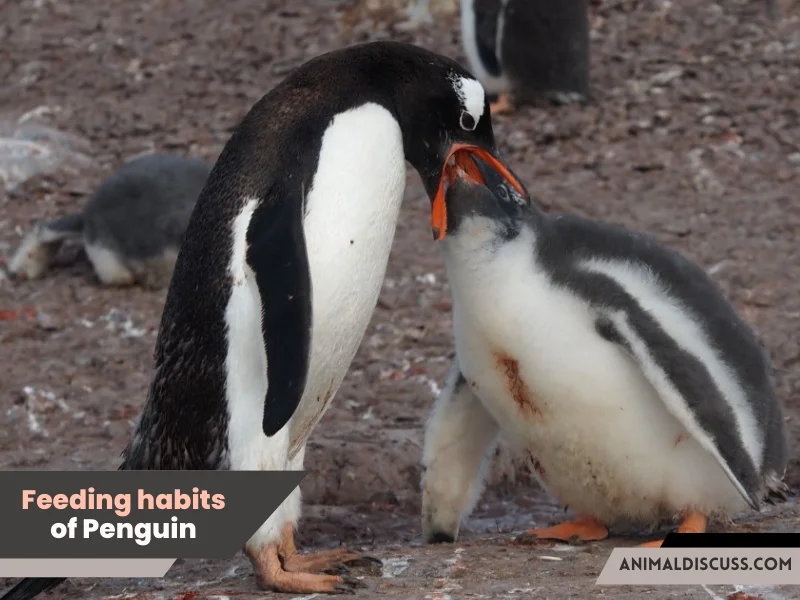
Adult Penguins:
Penguins are mainly carnivores and feed on fish, krill, and squid. Some species may dive to a depth of 500 meters (1,640 feet) to capture their prey. In order to enhance their chances of obtaining prey, penguins typically hunt in groups.
Adult penguins regurgitate the food they capture and give it to their chicks. However, certain species, like; the Emperor Penguin, may go without food for up to four months while caring for their young.
Penguin Chicks:
- The parents would go on hunting expeditions and then come back to the nest to regurgitate the food for the chicks.
- To help the chicks develop fast and prepare for their first swim, a high-fat diet is given to them.
- Penguin chicks rely on their parents for sustenance for several months until they can feed on their own.
Breeding (Mating) Habits:
Breeding behaviors describe how penguins act throughout the breeding season. This season is crucial to the species’ existence as it is when they breed and nurture their young. Species and environmental factors can influence a penguin’s mating patterns. However, some commonalities in their behavior are worth exploring:
Penguins are monogamous. That’s why they mate with the same spouse for life. Male penguins will compete with one another during mating season in order to stake out their territory and attract a mate. This might entail vocalization, aggressive displays, and other courting behaviors.
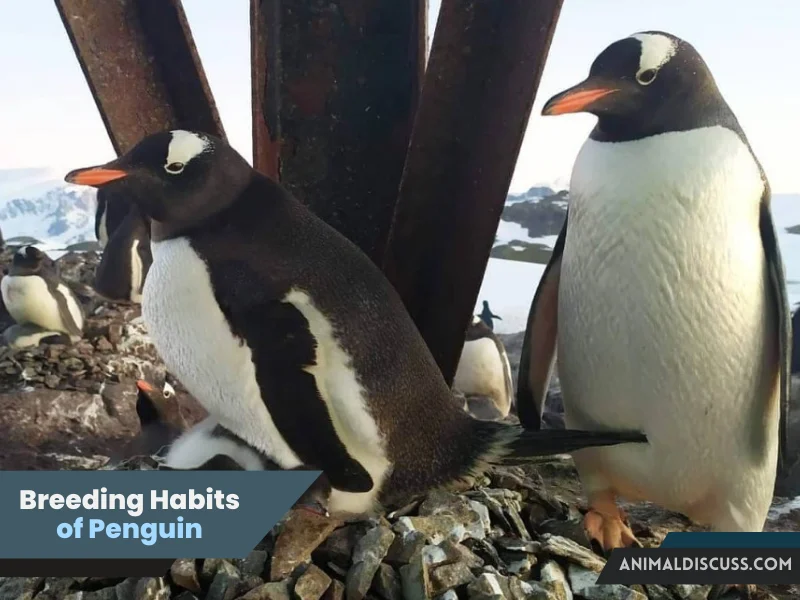
Once the pair has developed, they will cooperate to construct a nest and get ready to lay eggs. Female penguins normally lay one to two eggs at a time, and both parents take turns incubating them. It takes around 30-40 days for the eggs to hatch.
Breeding season typically ends when the chicks are old enough to fend for themselves and begin to molt their downy feathers.
Overall, Penguin reproductive practices are intriguing and essential to the species’ existence. Their dedication to monogamy and parenthood is remarkable, and it is intriguing and enjoyable to see their courting rituals.
Migration Patterns:
The distinctive migratory patterns of Penguins, which can differ between species, are well documented. The following information on Penguin migration is fascinating:
Penguins move every year to various habitats to breed and forage. Depending on the species and location, Penguin migration can occur at different times. For instance, some Penguins migrate to Antarctica in March, while others go to South Africa in June.
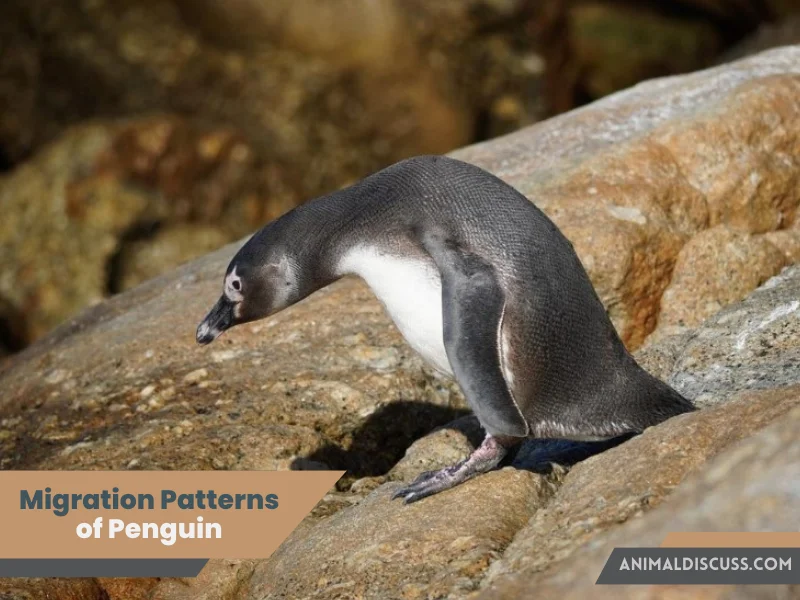
During their migration, certain Penguin species have been seen to cover thousands of kilometers.
Penguins have been seen to employ a variety of navigational techniques, such as the magnetic field of the Earth, the location of the sun, and even the sound of underwater landmarks.
In general, Penguin migration is an amazing phenomenon that enables these birds to live and prosper in many locations throughout the globe.
Ecological Adaptations
Penguins have developed a variety of adaptations to live and flourish in their particular surroundings, including:
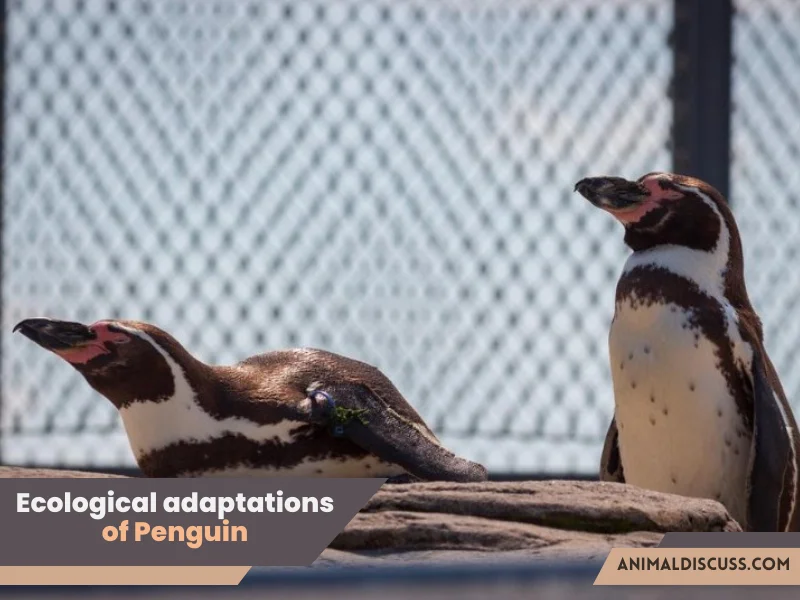
Waterproof feathers: The feathers on a penguin’s layer are tightly packed and cover each other to provide a waterproof barrier that keeps the downy feathers and the skin dry.
Salt glands: Penguins have unique glands above their eyes that enable them to eliminate extra salt from their bodies, a need for survival in their salty habitat.
Countercurrent heat exchange system: Penguins have a network of blood arteries in their legs and flippers that aid with heat retention in cold water by transferring heat from warm arterial blood to cold venous blood before it reaches the body’s extremities.
Efficient swimming: Penguins have streamlined bodies, flippers, and webbed feet that are designed for effective propulsion through the water. Penguins are great swimmers. They can swim up to 22 mph (35 kph) and dive to depths of up to 1,800 feet (550 meters) by their strong flippers.
Streamlined body shape: Penguins can grab prey and avoid predators because of their streamlined bodies, which enable them to swim quicker in the water.
Insulated feathers: Penguins are covered in a thick coat of insulating feathers that shield them from the wind, water, and cold, allowing them to keep their body heat in freezing conditions.
These adaptations have made penguins a fascinating and distinctive group of animals to study and appreciate, enabling them to survive in some of Earth’s roughest and most severe conditions.
Aggression and Territorial Habits
Aggression
Although penguins are lovely and cuddly, don’t be fooled by their attractive look. These birds are very violent and possessive when it comes to protecting their nesting locations, partners, and young. Here are some intriguing details on the territorial tendencies and violence of penguins:
Although they may appear calm and sociable, Penguins may be highly violent toward one another. Males vigorously guard their nesting places during the breeding season.
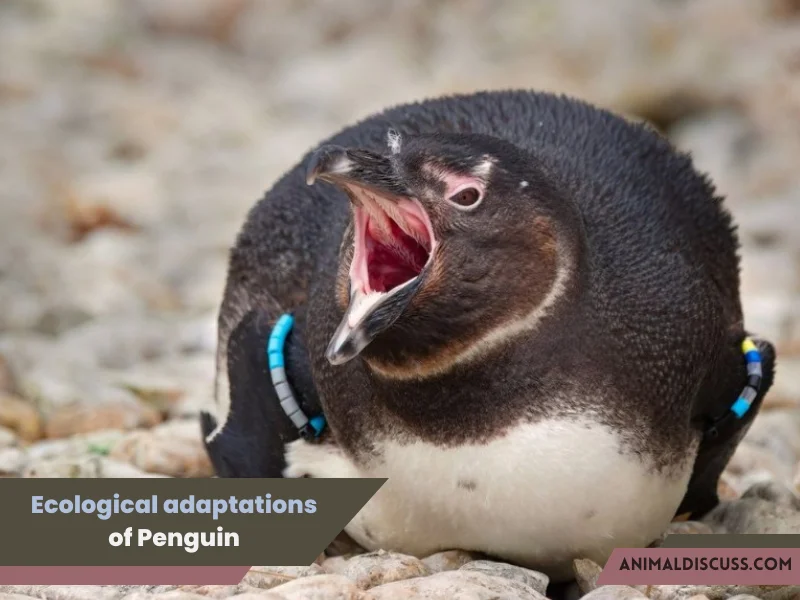
Penguins frequently use their sharp beaks as weapons when physical conflict comes out. Fighting between penguins using their beaks to bite and peck at each other until one gives in may be extremely severe.
Aggression may include physical displays such as pecking and flapping wings as well as vocalizations like squawking or hissing. It is often related to competition for the resources such as food or mates and can occur both within and between Penguin species.
Penguins can also use aggression to defend against predators, such as by mobbing or attacking predators that threaten their colony.
Territorial Habits:
- Penguins are territorial in their nesting areas and will fight off rivals of any type, including those of the same species.
- Territorial behavior can involve vocalizations like squawking or braying, physical displays like extending wings, and aggressive actions like pecking or biting.
- Territorial disputes can happen between penguins during mating season or when resources like food or nesting sites are limited.
- Penguins regularly return to the same nesting location year after year, fiercely defending it from other penguins that try to invade it.
Social Behavior
Penguins are really intriguing animals when it comes to their social interactions. These birds, who live in large colonies, engage in various behaviors that enable them to interact and survive in their hostile environs. Here are some fascinating details regarding penguin social behavior:
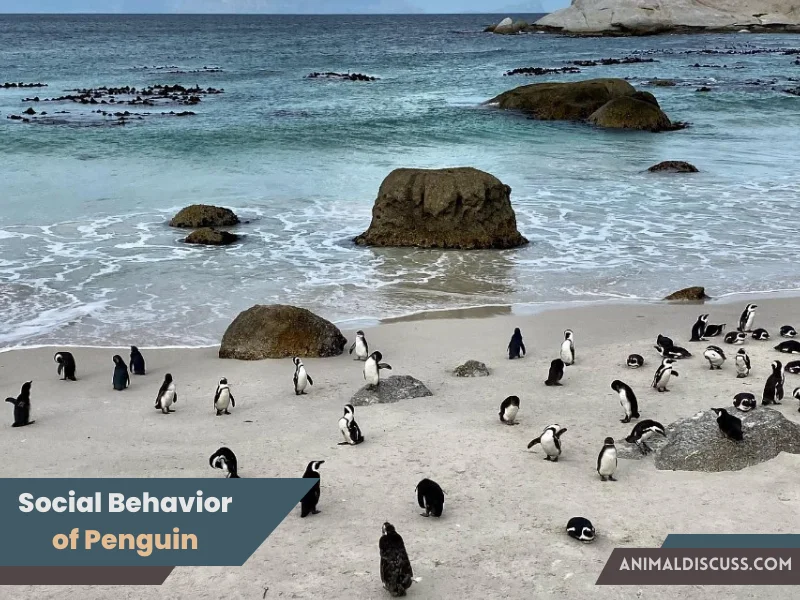
- Penguins are naturally very gregarious creatures, and they may live in colonies ranging from just a few individuals or as many as thousands.
- Penguins create social hierarchies inside these colonies through a sequence of interactions and displays. Food, mates, and other resources are often first made available to the dominant individuals.
- The construction of communal nests and the incubation of eggs are common behaviors among penguin species, with both parents sharing responsibilities for the care of the young.
- Penguins also interact with each other through preening, allopreening (mutual preening), and billing (touching bills). These actions foster group cohesiveness and develop social ties.
- It’s interesting to note that homosexual behaviors in Penguins have also been captured, including pair-bonding, courting, and even nest-building. Although the precise causes of this behavior are not entirely understood, it is believed to contribute to social bonding and the development of lifelong relationships.
Overall, Penguin social behavior is a fascinating and complicated subject, with a variety of unusual behaviors that help these birds survive and prosper in their particular settings.
Factors that influence different behavioral traits
Have you ever wondered why certain species of penguins are more hostile than others? Or why do particular penguins behave differently from other Penguins regarding their social interactions? These behavioral variations are impacted by several variables, including:
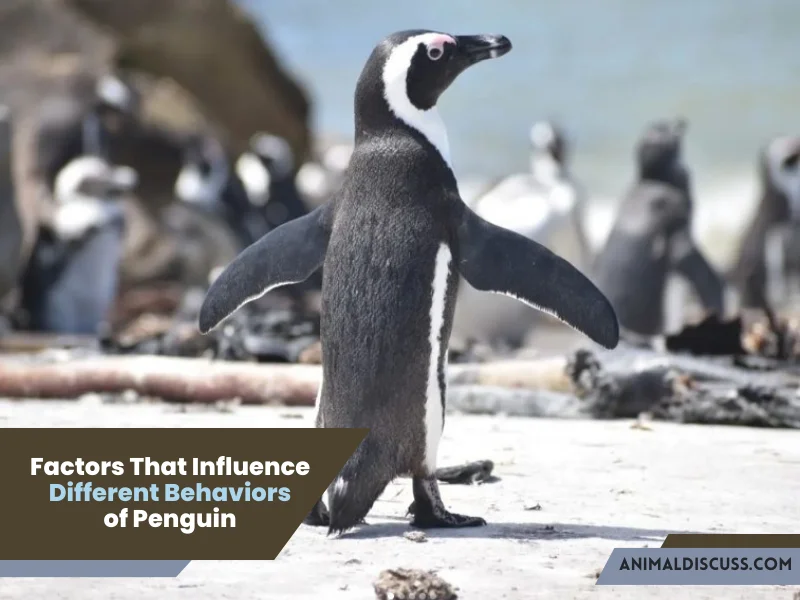
Habitat: Various kinds of penguins have evolved to fit into specific environments. For instance, Emperor Penguins live in Antarctica’s harsh, frigid habitat, whereas Galapagos Penguins flourish in the islands’ milder, tropical climate. Each species’ behavior and survival techniques have been influenced by these unique settings.
Food Availability: The availability of food is essential to a penguin’s survival, and various species have evolved to hunt different kinds of animals. Different behavioral patterns may result from this feeding specialization when their food supply is scarce.
Climate Change: Penguin behavior is significantly being impacted by climate change. Penguins must adapt to shifting conditions as their homes and food supplies change. As an illustration, scientists have noticed King Penguins changing their nesting habits in response to variations in sea ice patterns.
Predator Threats: Penguins are seriously at risk from predators, including seals and birds of prey. Penguins have therefore developed a variety of tactics to prevent becoming prey.
In conclusion, a number of variables, including habitat, food availability, warming temperatures, and predator threats, affect the behavioral features of penguins. Understanding these factors is essential to preserve and conserve these captivating species.
Human-induced factors that change animal behavior
Have you considered how people, even unintentionally, affect animal behavior? The unfortunate truth is that penguin behavior and that of other species may be significantly impacted by human activities like pollution, habitat degradation, and climate change. Here are a few scenarios:
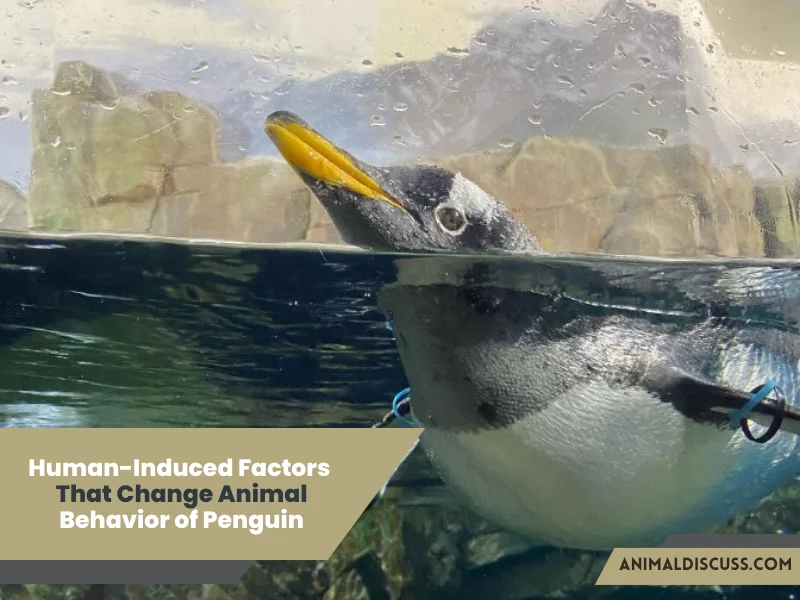
Pollution: Penguins’ behavior and capacity to find food might be affected by health problems brought on by polluted water and air. Particularly oil spills can have disastrous effects. It is challenging for penguins to swim and obtain food when they come into touch with oil because it interferes with their capacity to maintain buoyancy in the water and regulate their internal temperature.
Habitat destruction: Penguin habitats are frequently lost or disturbed as human populations increase and spread. Penguins may move to new regions as a result of the destruction of nesting grounds and disruption of feeding areas caused by the construction of buildings and roads. As a result, there may be more rivalry for resources, which may change how they behave.
Tourism: While it might allow visitors to understand and learn about penguins, tourism can also negatively impact their behavior. Uncontrolled tourism has the potential to harm penguin habitats and upset the birds. To guarantee that tourist operations are carried out in a responsible and sustainable way, it is crucial to have policies and laws in place.
These are only a few examples of how human actions may affect penguins’ and other animals’ behavior. We must take action to lessen our adverse environmental effects and work toward a sustainable future.
Conservation of their behavior
Preserving penguin behavior takes a mix of education, protection, restoration, and mitigation efforts. We may contribute to ensuring these remarkable animals’ existence for future generations by taking steps to preserve them.
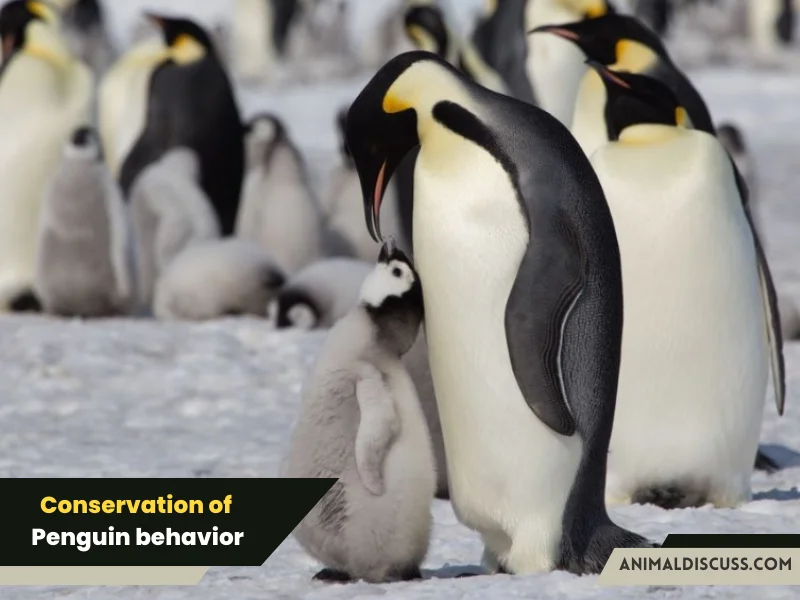
Reducing carbon emissions: We can lessen the consequences of climate change by cutting back on our carbon emissions by utilizing renewable energy, minimizing waste, and saving water.
Responsible tourism: We may also reduce the detrimental effects of tourism by encouraging actions that emphasize the security and welfare of penguins.
Protecting habitats: Penguins’ ability to survive depends on the preservation of their natural habitats. This can be achieved by establishing marine protected zones, enforcing fishing laws, and avoiding ocean pollution.
Education and awareness: We can motivate more people to take action and support conservation initiatives by raising awareness of the challenges they face.
Overall, we can all help to safeguard these magnificent species by taking a few steps to guarantee that future generations may enjoy them.
A number of institutions and organizations are actively striving to safeguard penguins and their habitats. By supporting these organizations through donations or volunteer work, we can help ensure their efforts succeed. The most notable ones are listed below:
01. The Global Penguin Society (GPS): This non-profit organization is dedicated to the conservation of penguins. They carry out research on penguin behavior and ecology, safeguard penguin habitats and breeding grounds, and spread awareness of the value of penguins to the larger environment.
02. The World Wildlife Fund (WWF): One of the biggest conservation groups in the world, the WWF strives to safeguard threatened species and their natural habitats. They have a number of programs aimed at safeguarding penguin breeding colonies, decreasing hazards from human activities, and encouraging sustainable fishing methods.
These institutions and organizations are just a few organizations fighting to safeguard penguins and their habitats. People may help penguin conservation efforts by supporting these organizations with money or volunteer activities.
Conclusion
As we have come to the end of this article on penguin behavior, it’s apparent that these marine creatures have much more to offer than just their adorable appearance.
It is also clear that these creatures are threatened in many ways, including by human-caused elements that may change their normal behavioral patterns. We can help secure these cherished species’ future by supporting sustainable practices and conservation groups like The Penguin Foundation.
Let’s all do our share to make sure that Penguins’ extraordinary behavior continues to astound and inspire people for years to come. To learn more about related topics such as food and diet, as well as different habitats that Penguins’ inhabit, we invite you to explore other articles on our site.
Meta: Discover the diverse behavioral traits of penguins, from Physical adaptations to social dynamics and ecological adaptations. Uncover the secrets of their growth, feeding, breeding, and migration patterns.
References:
- https://www.worldwildlife.org/species/penguin
- https://www.nationalgeographic.com/animals/birds/facts/penguins-1
- https://asoc.org/issues/protecting-antarctica/
Images Credit:
- Instagram.com

